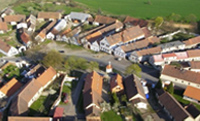History of Koterov
One of the most beautiful and best preserved rural village green in the Pilsen area has Koterov. This is evidenced by the wealth of local farmers and their sensitive relationship to the legacy of past generations. It's more interesting that it is a suburban community that was and is tied to industrial Pilsen. Name settlements in Bohemia is a unique property of origin. It was a village named after its founder Kotera or Kotora. In ancient sources is the name of the village fluctuated between Koterov and Kotorov, which is derived from the Slavic names of Kotor, this is dispute, fight.
The first written mention of Koterov is from 1369, although the village was certainly older. Probably a whole or at least in part, was given after the founding of the city of Pilsen in its assets. The earliest history of the village, however, are quite vague and First light brings them to deed of 28. March 1369, which is very valuable for understanding the social and legal relations of Czech villages. They were managed by old Czech law, under which the farmer simply hereditary tenant and the owner of the village whenever he could from his homestead recognized. Later, in particular from the beginning of the 14. century us spread the special law, according to which the user has already inherited the farm, owner of the land paid a yearly rent and was able to master the permission of his estate freely. The peasants were deprived of various, mainly provincial responsibility, robot and have the smaller villages in the management of their own affairs. Koterov was then in private possession and the said deed of 1369 it bought Pilsen citizen Vavřinec of Kralovice from brothers Mikuláš and Jakšt of Újezd.
The new owner of the charter in Koterov regulate legal relations and transferred to the village special right. The village had 12 fields (also farms ) and every field , users were required to pay 93 raps and miller 100 raps. In addition, each subject had to pay at Christmas 4 chickens and at Easter 40 eggs. If that was stored general royal tax, had each of field pay 20 pennies. At the same time regulated the management of the village, minor disputes with the inhabitants follow the law of the City of Pilsen, in more severe cases should contact the municipal court.
In a document from 1369 states that the village belonged to the hill Kolešovka lying towards Božkov and Mešnice, lying towards the Starý Plzenec. So it is the old name. The lack of historical sources does not allow us to monitor more closely the fate of the village, and when we learn about a number of other owners Koterov . Among them, around 1460 St. appears also chapter st. Apolinář in the New Town Prague, which belonged Bolevec , who in 1460 bought the city of Plzeň, in order to Bolevec plots established a large pond system. 1466 King George Poděbradský stopped Koterov Matouš of Všechovice in the sum of 400 penny and also ordered the new owner of the village that does not burden his subjects with new unfair fees and loads. In five years, however, Matouš sold Koterov to a new owner and then followed quite quickly behind another, until in 1507 it referred Petr Ebrzvín from Hradiště of Pilsen for commitment to the salaries that came out of the village, keep in the parish church at the altar of All Saints that Peter founded the chaplain. Donate was implemented in 1515 after the death of the donor and since then Koterov fully belonged city of Pilsen. Residents were relatively affluent, as evidenced by the discovery of coins in rebuilding the barn number 6. They found there gold ducats , three of which are stored in the museum.This is a coin from the second half of the 15th century, when it was in the Czech Republic among the inhabitants of considerable prosperity.
In a document from 1369 stated, that Koterov had 12 tracts and also many farmhouses. Their number is retained for a long time , as conditions in the country were conservative. In a tax rule from 1654 lists 9 farmers and 5 cottagers, who had an average of half the acreage of fields than farmers. Later they were called “pololáníci”. In 1714, these fourteen denizens were joined by newly settled next to the miller 's been mostly sojourners . In total there were 23 settlers and local cottage. In the same year, the Commission stated that the buildings are larger piece of wood, which is only a little more than a stone from the neighboring Letkov. Gardens people back then were well equipped and planted plum. Miller Ondřej Čechura had a mill on the volatile composition of the water for two and one foot. In the village since the 16th century blacksmith shop and tavern, which was about the 1565 dispute. Shortly before the latter has Šťáhlavy estate predatory Jiří Kokořovec and asked Pilsner inhabitants to stop the taproom, because it is said to harm and damage to his farm. Summoning witnesses of Koterov, Černice and Letkov emphasized, that beer in a Koterov tavern is from of old.
The increase in settlements in the first half of the 18th century testifies to the demographic explosion of the Czech countryside. In Koterov at that time was probably enough land, as the newly formed were built in nine cases, the peasant and six on municipal land. The village was about this development is saturated , and thus the end of 18 century we see as a result not a big increase, as was the case in some other villages in Pilsen . Extensive land lord Justice in neighboring Božkov gained ground not only existing local landless, but some farmers. Their wealth was later reflected in the exhibition houses and cottages, highlighting the confidence of farmers and crofters.
The relative prosperity in Koterov late of the 18th century, especially in the early 19th century was reflected, as already mentioned, the construction of farmsteads and cottages. In addition to doors and entrances to the farm in Koterov focused on the shields of residential buildings, which were well structured and decorated pillars and cornices, straight, but also baroque. The builder would like to show off at the gate or on the shield and your name, and even the year, when the farm was built. Along with the two chapels provides Koterovská náves i beautiful testimony of local residents about their affluence. The construction alternates several architectural styles - Renaissance, Baroque and Empire - and tell us about the late reception of these styles from the nearby town to village architecture. Chapel on the square is the baroque, the second from 1700 is also Baroque and is on the road to Starý Plzenec.
Koterov in the course of its existence gradually builded up. The old village is spread along the long village, which extended downward. In Koterov it drove along the road that faces away from Pilsen over to Starý Plzenec. In the 18th century when a large demographic boom cottagers and sojourners built houses and cottages in the village line, parallel to the river to the mill, and thence at right angles to road in Starý Plzenec. They called here "Pod chalupy". In the last century expanded area mentioned by the road and a new district called " Ha Hradčanech". Then builded up field “Za Kovárnou" and towards "K Hajím" in the course to Letkov. Before World War II began construction in and around the railway station Koterov and construction on the territory, where the Land Koterov meet with Pilsen and Černice, still continues.
Agricultural production was Koterov at the same level as in the surrounding villages. Machines come in Koterova quite late, in the sixties of the last century (1864 manual threshing, 1870 treadmill). The farmers had an average of one workman and two maids. Koterov developed in the last century rather slowly, until the construction of the railroad Pilsen - Czech Budejovice in 1867 brought a revival of the village, it allowed faster and better connections with Pilsen, where they began to travel in large numbers especially after 1900 people for work. Also contributed to the construction of the road Plzeň – Starý Plzenec 1903. By the Koterov began to settle workers spread in the village and socialist ideas and in 1904 there was established a local organization of social democratic, just after 1918 created the National Socialist organizations and agrarian. In 1914 was founded the Workers' Gymnastics Club. In the twenties of the 20th century was Koterov several factories and enterprises: a mill, factory Theinerová millstones and machinery, together, a blacksmith, two carpenters and two bricklayers. Two trades look after to supply for the population, otherwise people collected their needs in Pilsen.
Cultural life was quite brisk. The school was in the village since 1873, since the twenties there were held lectures and participation was relatively large, each about a hundred people. The local associations (Sokol , DTJ, Worker's amateur club, Volunteer firefighters ) had an average of two to three amateur performances annually . Also, there used to be an annual five dances balls.
Koterov was not so populated and industrial working class as the other more municipalities, which are directly associated with the city. The largest growth experienced Koterov in the interwar period. In 1850 the population was 355, in 1900 531, in 1921 it 749 s 1 1930 013 after the war in 1950 there were already 1,672 people. Then there was a drop caused by the fact that some of the related construction of Pilsen were attached to it, so Koterov 1970 showed only 517 inhabitants. This was related also to changes in the administrative organization in Pilsen. When you create Pilsen Municipality was 1942 Koterov connected with the town in one village. But because it was a traditional agricultural village (in 1952 in the village was based agricultural cooperative) in 1964 Koterov with other agricultural parts of Pilsen and embodied allocated to the district Plzeň -South. But when another reorganization in 1976 was again connected to the city and became part of the District National Committee Pilsen 2.
A city bus line Plzeň - Koterov – Starý Plzenec, introduced in 1949, allowed a quick and convenient connection to Pilsen. This was reflected in the construction of new communities, especially in the last decade have created a modern dwellings in family houses. Koterov growing, but new development does not violate the old historic core, which is a rare monument of folk architecture and its preservation is to the credit of the present village and town of Pilsen.







